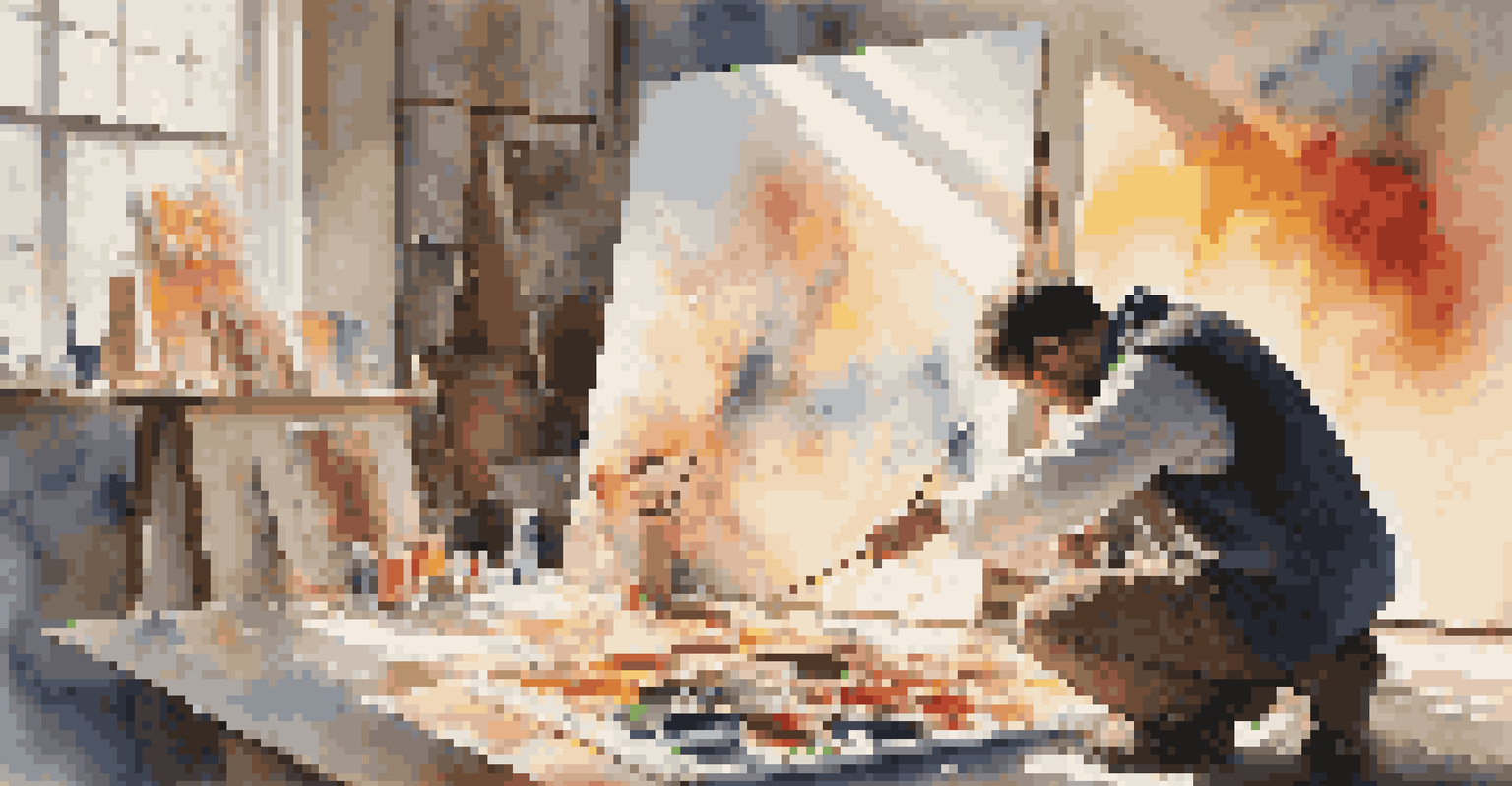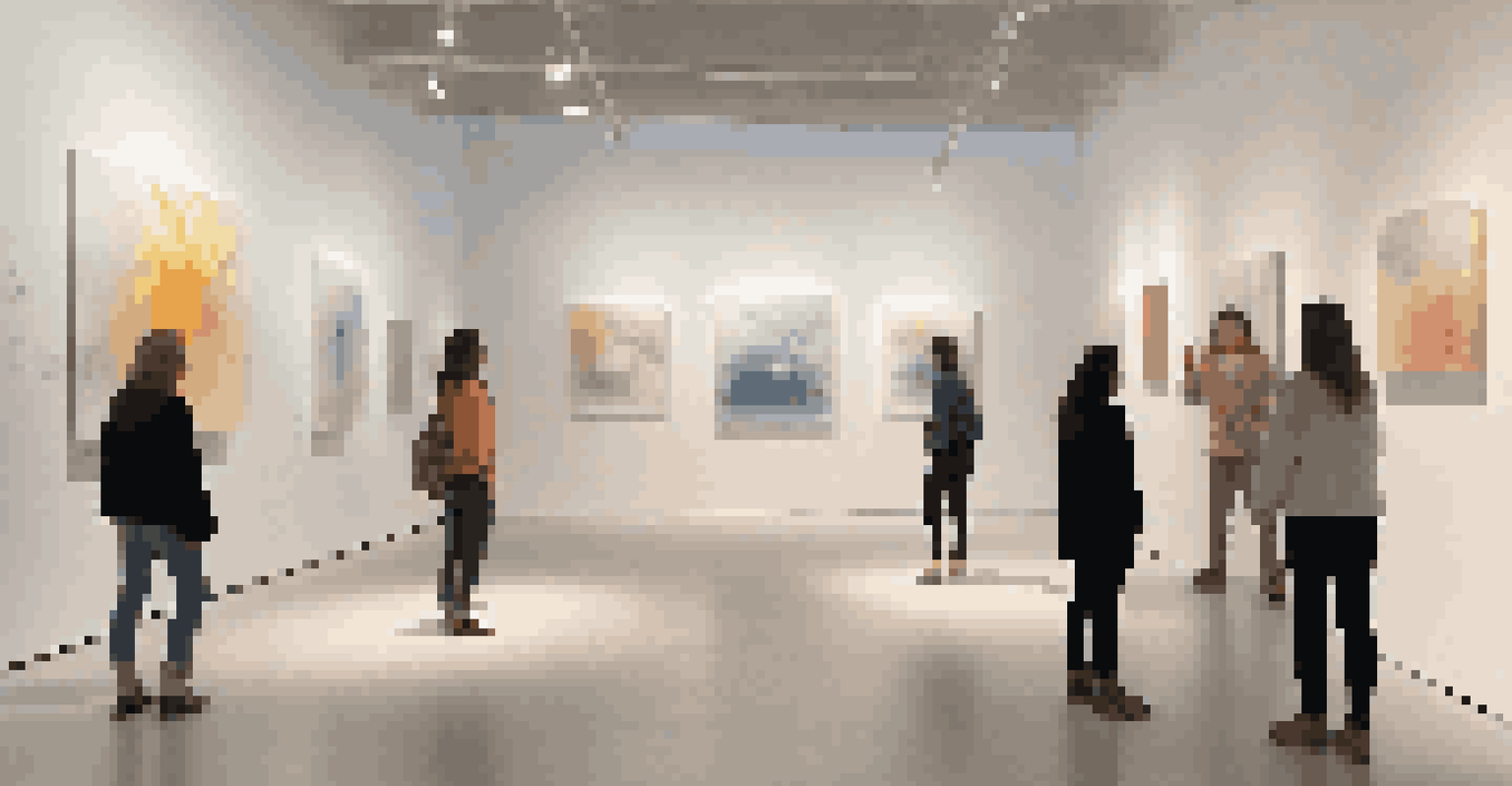The Sacred and the Profane: Art in Religious Contexts

Understanding the Sacred and the Profane in Art
The concepts of the sacred and the profane are pivotal in understanding religious art. The 'sacred' refers to the divine, the holy, and the revered, while the 'profane' encompasses the ordinary and secular aspects of life. This duality creates a rich tapestry in art, where sacred themes are often depicted through various forms, inviting viewers to reflect on their spirituality.
Art is the most beautiful of all lies; it is the most truthful of all truths.
For instance, consider how churches are adorned with intricate stained glass windows. These windows not only serve an aesthetic purpose but also narrate biblical stories, elevating the sacred experience of worship. The interplay between what is sacred and profane is where art becomes a bridge, connecting the divine with everyday life.
Ultimately, understanding these concepts allows us to appreciate how artists navigate between these worlds, creating works that resonate deeply within different cultural contexts. This exploration opens a dialogue about the intention behind religious art and its impact on both personal and communal belief systems.
Historical Perspectives on Religious Art
Throughout history, art has played a significant role in religious expression, from ancient rituals to contemporary practices. In ancient cultures, such as the Egyptians and Greeks, art was integral to worship, often depicting deities and mythological narratives. These early forms of religious art were not just for aesthetic pleasure; they were vital in conveying beliefs and rituals to the masses.

As time progressed, the Renaissance brought a renewed focus on humanism, blending the sacred with the profane. Artists like Michelangelo and Raphael infused their religious works with human emotions and experiences, making divine stories more relatable to the viewer. This shift highlighted how art could serve as a medium for both reverence and personal connection.
Sacred vs. Profane in Art
The interplay between sacred and profane themes in art fosters reflection on spirituality and everyday life.
Understanding these historical contexts enriches our appreciation for religious art today. It sheds light on how artists have continuously adapted their work to reflect changing beliefs, societal norms, and cultural influences, showcasing the evolving relationship between art and religion.
Symbolism in Sacred Art
Symbolism is a cornerstone of sacred art, often used to convey complex spiritual ideas in a relatable manner. Artists employ various symbols—such as light, color, and specific objects—to communicate deeper meanings and evoke feelings. For instance, a dove often symbolizes peace and the Holy Spirit, while the lotus flower represents purity and enlightenment in many Eastern traditions.
The artist is a creator of things. Therefore, he must be a creator of the sacred.
These symbols not only enrich the visual experience but also invite viewers to engage in a deeper exploration of their faith. They act as visual metaphors, bridging the gap between the material and spiritual realms. This layer of meaning enhances the viewer's connection to the artwork and its religious significance.
By understanding the symbolism in sacred art, we can better appreciate the artist's intent and the cultural context in which the piece was created. This perspective transforms how we interact with these works, encouraging us to delve deeper into their spiritual messages.
The Role of Ritual in Art Creation
Ritual plays a crucial role in the creation of sacred art, often guiding the artist's process and intent. Many artists engage in spiritual practices or ceremonies before beginning their work, seeking inspiration and connection to the divine. This practice can be seen in various cultures, from Native American sand painting to the meticulous preparation of materials in traditional Japanese calligraphy.
These rituals not only enhance the artistic process but also imbue the artwork with a sense of sacredness. The act of creating becomes a spiritual journey, where the artist channels their beliefs and experiences into the piece. This relationship between ritual and art highlights how deeply intertwined creativity and spirituality can be.
Role of Ritual in Art Creation
Rituals deeply influence the artistic process, connecting the artist's spiritual journey to the creation of sacred art.
By recognizing the importance of ritual in art creation, we can appreciate the profound dedication artists have to their craft. It emphasizes that the resulting artwork is not merely a product but a manifestation of their spiritual journey and connection to the sacred.
Contemporary Religious Art: Trends and Innovations
In today's world, contemporary religious art has evolved significantly, reflecting current societal issues and personal beliefs. Artists are experimenting with various mediums, including digital art, installation, and performance, to express spiritual themes. This shift allows for a broader interpretation of what constitutes religious art, making it accessible to diverse audiences.
For example, contemporary installations often incorporate interactive elements, inviting viewers to engage with the spiritual themes presented. This engagement fosters a sense of community and shared experience, breaking down traditional barriers between the artwork and the observer. It also encourages dialogue around faith, spirituality, and personal beliefs in a modern context.
As we explore contemporary religious art, we see how artists are reimagining sacred themes to resonate with today's challenges and triumphs. This innovation ensures that sacred art remains relevant and continues to inspire, provoke thought, and foster connection.
Art as a Medium for Interfaith Dialogue
Art has the unique ability to transcend cultural and religious boundaries, serving as a powerful medium for interfaith dialogue. Through shared artistic expressions, individuals from different faiths can come together to explore common themes of humanity, spirituality, and experience. This interaction fosters understanding and respect among diverse religious communities.
For instance, exhibitions that showcase art from various religious traditions can spark conversations about beliefs, practices, and values. By presenting art that reflects different perspectives, these events create a safe space for dialogue, allowing individuals to learn from one another. This exchange can dispel misconceptions and promote harmony among differing faiths.
Technology Transforms Religious Art
Advancements in technology provide new avenues for artists to express and share religious themes, enhancing viewer engagement.
In essence, art serves as a universal language that can unite people in their search for meaning and connection. By leveraging the power of art, we can cultivate a deeper appreciation for our shared human experience, paving the way for a more inclusive and understanding world.
The Impact of Technology on Religious Art
Technology has dramatically transformed the landscape of religious art, offering new tools and platforms for expression. Digital media, virtual reality, and social media have opened doors for artists to share their work with a global audience, breaking down geographical barriers. This accessibility allows for a richer exchange of ideas and perspectives in the realm of sacred art.
For example, virtual reality experiences can immerse viewers in sacred spaces, allowing them to engage with religious art in ways that were previously unimaginable. This innovative approach not only enhances the viewer's experience but also invites them to reflect on the spiritual themes presented in a more personal manner. It creates an interactive dialogue between the audience and the artwork.

As we navigate this digital age, it's essential to consider the implications of technology on the creation and appreciation of religious art. While it offers exciting opportunities, it also challenges traditional notions of authenticity and connection to the sacred. Embracing these changes can lead to new forms of expression that resonate with contemporary audiences.